
Villa Lewaro, formerly known as the Anne E. Poth Home, is a 34-room 20,000-square-foot (1,900 m2) mansion located at Fargo Lane and North Broadway in Irvington, New York, 30 miles north of New York City. It was built from 1916 to 1918, and was designed in the Italianate style by architect Vertner Tandy for A’lelia Walker, for her mother, Madam C.J. Walker.
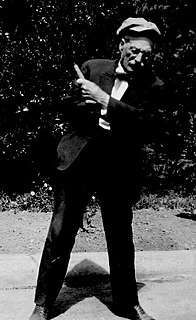
Frederick Louis Roehrig was an early 20th-century American architect. Roehrig was born in LeRoy, New York, the son of the noted "orientalist and philoligist," Frederick L.O. Roehrig He graduated from Cornell University in 1883 and also studied architecture in England and France. His architectural styles evolved over time, covering the Victorian, American Craftsman, and Neo-Classical styles. Roehrig is particularly known for his many landmark buildings in Pasadena, California, including the Hotel Green, and Pasadena Heritage has occasionally conducted tours of Roehrig's buildings.

Lincoln Heights Branch Library is the second oldest branch library in the Los Angeles Public Library system. Located in the Lincoln Heights section of Los Angeles, California, it was built in the Classical Revival and Italian Renaissance Revival styles in 1916 with a grant from Andrew Carnegie. One of three surviving Carnegie libraries in Los Angeles, it has been designated as a Historic-Cultural Monument and listed on the National Register of Historic Places.
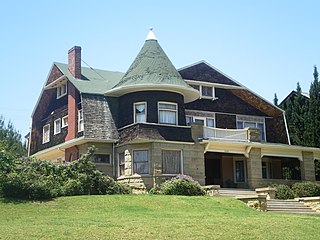
Alvarado Terrace Historical District is a designated historic district in the Pico-Union district of Los Angeles, California. It is located southwest of Downtown Los Angeles, along Alvarado Terrace between Pico Boulevard and Alvarado Street.
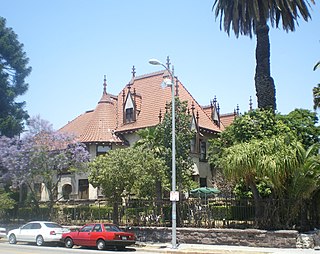
Susana Machado Bernard House and Barn is an elaborate 10,000-square-foot (930 m2) Art Nouveau Gothic Revival style mansion and carriage house located in the Pico Union section of Los Angeles, California. Built in 1901, the house was designed by architect John B. Parkinson (1861–1935). Parkinson also designed the Los Angeles Memorial Coliseum, Union Station and Los Angeles City Hall. Noted for its Gothic style with soaring spaces, the house has vaulted ceilings and curved walls. In 1979, it was designated a Los Angeles Historic-Cultural Monument, and listed on the National Register of Historic Places. The property was purchased in 1996 by the Center for Human Rights & Constitutional Law. Since 2002, the house has been operated as the Casa Libre/Freedom House, a fourteen-bed shelter for homeless minors. In May 2003, the Los Angeles Times profiled the shelter, noting the following: "Casa Libre/Freedom House occupies a newly renovated mansion near MacArthur Park. Registered as a state, county and federal historic site, the home's gothic facade rises elegantly from the corner of South Lake Street and James M. Wood Boulevard. The shelter arranges for schooling, counseling, and medical care for undocumented and unaccompanied immigrant children, mainly from Latin America.

The Frederick Mitchell Mooers House, also known as the Wright-Mooers House, is an ornately detailed Victorian house built in 1894 at 818 South Bonnie Brae Street in the Westlake area of Los Angeles, California. It is named after the wealthy gold miner who owned the house from 1898 to 1900.

The Frederick Hastings Rindge House is a historic house located in the West Adams district of Los Angeles, in Los Angeles County, California.

The North University Park Historic District is a historic district in the North University Park neighborhood of Los Angeles, California. The district is bounded by West Adams Boulevard on the north, Magnolia Avenue on the west, Hoover Street on the east, and 28th Street on the south. The district contains numerous well-preserved Victorian houses dating back as far as 1880. In 2004, the district was added to the National Register of Historic Places.
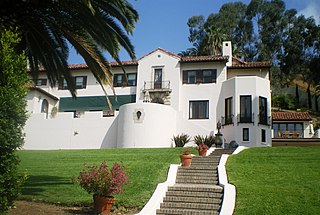
The C. E. Toberman Estate, also known as Villa Las Colinas, is a gated Mission Revival mansion and estate on Camino Palmero in Hollywood, Los Angeles, California. It was listed on the National Register of Historic Places in 1983, and as a Los Angeles Historic-Cultural Monument in 1984.
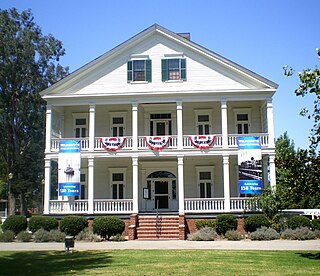
Banning House, also known as the General Phineas Banning Residence Museum, is a historic Greek Revival-Victorian home in the Wilmington section of Los Angeles, California. Built in 1863 by Phineas Banning near the original San Pedro Bay, it remained in the Banning family until 1925 and has been owned by the City of Los Angeles since 1927. The home, barn and gardens are now operated as a museum. The Banning House property, also known as Banning Park, has been designated as a city Los Angeles Historic-Cultural Monument and state California Historical Landmark and has been federally listed on the National Register of Historic Places.

The Harold Lloyd Estate, also known as Greenacres, is a large mansion and landscaped estate located in the Benedict Canyon section of Beverly Hills, California. Built in the late 1920s by silent film star Harold Lloyd, it remained Lloyd's home until his death in 1971. The estate originally consisted of a 44-room mansion, golf course, outbuildings, and 900-foot (270 m) canoe run on 15 acres (61,000 m2). Greenacres has been called "the most impressive movie star's estate ever created." After Lloyd died, the acreage in the lower part of the estate along Benedict Canyon was subdivided into approximately 14 large home lots. The mansion, on top of its own hill, retained approximately 5 original acres of flat land. It was added to the National Register of Historic Places in 1984.

The Adamson House and its associated land, which was known as Vaquero Hill in the nineteenth century, is a historic house and gardens in Malibu, California. The residence and estate is on the coast, within Malibu Lagoon State Beach park.

Elmer Grey, FAIA was an American architect and artist based in Pasadena, California. Grey designed many noted landmarks in Southern California, including the Beverly Hills Hotel, the Huntington Art Gallery, the Pasadena Playhouse and Wattles Mansion. He is credited with being one of the pioneers in the development of the new American architecture in the early 20th century, with a focus on harmony with nature and eliminating features not belonging to the local climate and conditions. Grey was also a noted artist whose paintings are in the permanent collection of the Chicago Art Institute.

The Orcutt Ranch Horticulture Center, formally known as Rancho Sombra del Roble, is a Los Angeles Historic-Cultural Monument located in the West Hills section of Los Angeles, California, USA.

Victoria Park is a small neighborhood in the central region of Los Angeles, California. There are three Los Angeles Historic-Cultural Monuments located in Victoria Park.

Ho Tung Gardens, also known by its Cantonese name 'Hiu Kok Yuen', was a villa on the Peak, Hong Kong. It was built by Robert Hotung and his wife Clara in 1927. They referred to it as "The Falls", but it later became known as Ho Tung Gardens.
Allen Siple (1900-1973) was an American architect, working in Southern California from the 1930s to 1960s.

Hollywood Heights is a neighborhood in the Hollywood Hills of Los Angeles, bounded by the Hollywood Bowl on the north, Highland Avenue on the east, Outpost Estates on the west, and Franklin Avenue on the south. It includes a number of notable historic homes and buildings and has been home to numerous people in the film and music industries, dating back to the silent film era.
The Villa Aurora at 520 Paseo Miramar is located in Pacific Palisades, Los Angeles and has been used as an artists residence since 1995. It is the former home of the German-Jewish author Lion Feuchtwanger and his wife Marta. The Feuchtwangers bought this Spanish-style mansion in 1943 for only $9,000, the annual salary of a school teacher. The house was a popular meeting place for artists and the community of German-speaking émigrés. Lion Feuchtwanger wrote six of his historical novels in this house: Der Tag wird kommen, Waffen für Amerika, Die Jüdin von Toledo, Narrenweisheit oder Tod und Verklärung des Jean-Jacques Rousseau, Jefta und seine Töchter, and Goya oder der arge Weg der Erkenntnis.





















